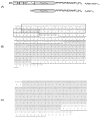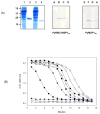Genetic linkage of autologous T cell epitopes in a chimeric recombinant construct improves anti-parasite and anti-disease protective effect of a malaria vaccine candidate
- PMID: 20097151
- PMCID: PMC2844075
- DOI: 10.1016/j.vaccine.2010.01.019
Genetic linkage of autologous T cell epitopes in a chimeric recombinant construct improves anti-parasite and anti-disease protective effect of a malaria vaccine candidate
Abstract
We have reported the design of polyvalent synthetic and recombinant chimeras that include promiscuous T cell epitopes as a viable delivery system for pre-erythrocytic subunit malaria vaccines. To further assess the ability of several Plasmodium T cell epitopes to enhance vaccine potency, we designed a synthetic gene encoding four Plasmodium yoelii merozoite surface protein 1 (PyMSP1) CD4(+) promiscuous T cell epitopes fused in tandem to the homologous carboxyl terminal PyMSP1(19) fragment. This Recombinant Modular Chimera (PyRMC-MSP1(19)) was tested for immunogenicity and protective efficacy in comparative experiments with a recombinant protein expressing only the PyMSP1(19) fragment. Both proteins induced comparable antibody responses. However PyRMC-MSP1(19) elicited higher anti-parasite antibody titers and more robust protection against both hyper-parasitemia and malarial anemia. Most importantly, passive transfer of anti-PyRMC-MSP1(19), but not anti-PyMSP1(19) antibodies protected against heterologous challenge. These studies show that protective efficacy can be significantly improved by inclusion of an array of autologous promiscuous T cell epitopes in vaccine constructs.
Copyright 2010 Elsevier Ltd. All rights reserved.
Figures






Similar articles
-
Expression of disulphide-bridge-dependent conformational epitopes and immunogenicity of the carboxy-terminal 19 kDa domain of Plasmodium yoelii merozoite surface protein-1 in live attenuated Salmonella vaccine strains.Microbiology (Reading). 1999 Jan;145 ( Pt 1):221-229. doi: 10.1099/13500872-145-1-221. Microbiology (Reading). 1999. PMID: 10206702
-
Protective immune responses elicited by immunization with a chimeric blood-stage malaria vaccine persist but are not boosted by Plasmodium yoelii challenge infection.Vaccine. 2010 Oct 4;28(42):6876-84. doi: 10.1016/j.vaccine.2010.08.018. Epub 2010 Aug 13. Vaccine. 2010. PMID: 20709001 Free PMC article.
-
Production, characterisation and immunogenicity of a plant-made Plasmodium antigen--the 19 kDa C-terminal fragment of Plasmodium yoelii merozoite surface protein 1.Appl Microbiol Biotechnol. 2012 Apr;94(1):151-61. doi: 10.1007/s00253-011-3772-7. Epub 2011 Dec 15. Appl Microbiol Biotechnol. 2012. PMID: 22170105
-
Identification of T cell epitopes on the 33-kDa fragment of Plasmodium yoelii merozoite surface protein 1 and their antibody-independent protective role in immunity to blood stage malaria.J Immunol. 2002 Jul 15;169(2):944-51. doi: 10.4049/jimmunol.169.2.944. J Immunol. 2002. PMID: 12097400
-
Merozoite surface protein 1-specific immune response is protective against exoerythrocytic forms of Plasmodium yoelii.Infect Immun. 2002 Nov;70(11):6075-82. doi: 10.1128/IAI.70.11.6075-6082.2002. Infect Immun. 2002. PMID: 12379684 Free PMC article.
Cited by
-
A Chimeric Plasmodium vivax Merozoite Surface Protein Antibody Recognizes and Blocks Erythrocytic P. cynomolgi Berok Merozoites In Vitro.Infect Immun. 2021 Jan 19;89(2):e00645-20. doi: 10.1128/IAI.00645-20. Print 2021 Jan 19. Infect Immun. 2021. PMID: 33199351 Free PMC article.
-
TACI Contributes to Plasmodium yoelii Host Resistance by Controlling T Follicular Helper Cell Response and Germinal Center Formation.Front Immunol. 2018 Nov 9;9:2612. doi: 10.3389/fimmu.2018.02612. eCollection 2018. Front Immunol. 2018. PMID: 30473702 Free PMC article.
-
A prime-boost immunization regimen based on a simian adenovirus 36 vectored multi-stage malaria vaccine induces protective immunity in mice.Vaccine. 2017 May 31;35(24):3239-3248. doi: 10.1016/j.vaccine.2017.04.062. Epub 2017 May 5. Vaccine. 2017. PMID: 28483199 Free PMC article.
-
A Plasmodium Promiscuous T Cell Epitope Delivered within the Ad5 Hexon Protein Enhances the Protective Efficacy of a Protein Based Malaria Vaccine.PLoS One. 2016 Apr 29;11(4):e0154819. doi: 10.1371/journal.pone.0154819. eCollection 2016. PLoS One. 2016. PMID: 27128437 Free PMC article.
-
Induction of Multifunctional Broadly Reactive T Cell Responses by a Plasmodium vivax Circumsporozoite Protein Recombinant Chimera.Infect Immun. 2015 Sep;83(9):3749-61. doi: 10.1128/IAI.00480-15. Epub 2015 Jul 13. Infect Immun. 2015. PMID: 26169267 Free PMC article.
References
-
- Organization WH, editor. WHO. World malaria report 2008. Geneva: WHO Press; 2008.
-
- Langhorne J, Ndungu FM, Sponaas AM, Marsh K. Immunity to malaria: more questions than answers. Nat Immunol. 2008;9(7):725–32. - PubMed
-
- Conway DJ, Cavanagh DR, Tanabe K, Roper C, Mikes ZS, Sakihama N, et al. A principal target of human immunity to malaria identified by molecular population genetic and immunological analyses. Nat Med. 2000;6(6):689–92. - PubMed
-
- Kester KE, Cummings JF, Ockenhouse CF, Nielsen R, Hall BT, Gordon DM, et al. Phase 2a trial of 0, 1, and 3 month and 0, 7, and 28 day immunization schedules of malaria vaccine RTS,S/AS02 in malaria-naive adults at the Walter Reed Army Institute of Research. Vaccine. 2008;26(18):2191–202. - PubMed
Publication types
MeSH terms
Substances
Grants and funding
LinkOut - more resources
Full Text Sources
Other Literature Sources
Medical
Research Materials

